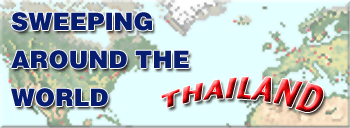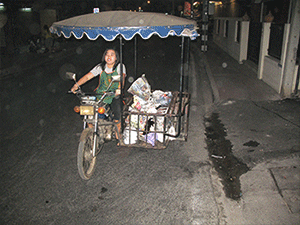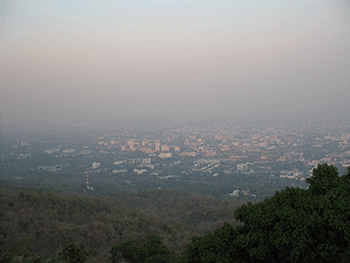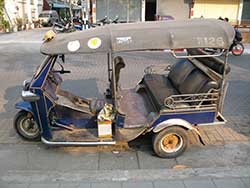
 |
An Overview of Chiang Mai, Thailandby Ranger Kidwell-Ross
When the Chiang Mai City Municipality was formed in 1933 it was the first such local government entity to be established in Thailand. Today, there are four municipal sub-districts, with a total size of approximately 40 sq. km. I was impressed at the level of street sweeping activity I saw, even before meeting with officials from the municipal agency responsible for cleanup. Hardly do leaves collect in the gutter before someone is there with a broom and dustpan cleaning them up. Other litter is dealt with swiftly, as well. In addition to scheduled routes, the agency appeared to have some type of hotspot notification system, because any place that had litter-producing activity was quickly cleaned. This included places where leaves were falling.
All of these draw a high level of traffic to the area, with the usual attendant litter from customers as well as some amount of debris left over from vendors. The first animated photos shows a typical vendor booth from Chiang Mai's Wednesday Street Market, and then what the street looks like once the booths are packed away. As the vendors are still dismantling the market infrastructure, and before the manual sweeping personnel appear, people usually come by looking for items they can make money on by picking them up to recycle. The photo of the tricycle shown in the animation below is a collection vehicle for any paper left alongside the street at the close of the market. Another woman, not shown, was walking ahead getting all the paper she could find, then loading it into the trike's basket. The driver pedaled along the street to keep the container basket handy. These folks were not part of any official cleanup crew; rather, they were people scrounging to make a Baht.  They have to be quick, because soon after the markets wrap up the manual sweeping crew makes their way down the street. In most instances that I saw the crews were somewhere between 10 and 20 in number. They bag all the large debris, as well as whatever they sweep up from the sidewalks and curbs. Usually within an hour or so all vestiges of the market having been there have disappeared.
They have to be quick, because soon after the markets wrap up the manual sweeping crew makes their way down the street. In most instances that I saw the crews were somewhere between 10 and 20 in number. They bag all the large debris, as well as whatever they sweep up from the sidewalks and curbs. Usually within an hour or so all vestiges of the market having been there have disappeared.
In the Thai culture, it's easy to see why an emphasis would be given to manual sweeping with brooms and containers. After all, wages are extremely low, as compared to Western standards. A friend I visited in northern Thailand, who is getting 10 acres ready for cultivation, said he regularly gets offers to labor at the rate of 120 Thai Baht per day. Considering the current exchange rate of between 30 - 35 Baht per $1US, no doubt machine-based sweeping is relatively expensive.
When I was in Chiang Mai in mid-February of 2007, air pollution from dust particles were definitely a problem. In dust non-attainment areas in the U.S., an increased emphasis on sweeping with air sweepers would be a leading part of working toward a solution. However, from what I saw, before an emphasis on increased and/or a better level of sweeping will make a difference, the local and regional sources of the dust must be addressed. For example, a seeming majority of the cycles and taxis in town both are in need of new mufflers and smoke badly. I'm told the latter isn't, as I initially thought, because the engines need rebuilt. Rather, most just need the air filter replaced or the fuel injectors cleaned. The largely non-mechanical Thai vehicle owners just don't seem to get around to doing either. Although I'm told an emissions testing requirement is on the books, it is not being enforced. However, the largest factor during this time of year is the region's annual outdoor burning ritual. The worst haze source apparently stems from fires in nearby Myanmar (formerly Burma), but the practice is also widespread in Northern Thailand and another bordering country to the north, Laos. Burning is still the method of preference for both land clearing and minimizing long-term forest fire danger (by burning all the underbrush on a yearly basis). A big problem with stopping it, as is the case in so many regions of the world, is that this practice has taken place for millennia. The difference is that population growth and weather changes now makes 'the old ways' no longer viable. 
As may be seen by the sunset pictures you see to the right, which I took from Suthep Mountain at the end of February, the air became infused with minute, PM10 dust particles (measuring less than 10 microns in diameter; an average human hair is 72 microns wide). It was an eye-stinging, throat-burning, yellow-tinged haze. A little worse each day, by the first two weeks of March air pollution levels in Chiang Mai and the surrounding regions rose above the safety limit. Officials cited unusual weather conditions as a contributant, including the lack of rain and a cold air mass that prevented dust particles from dissipating into the atmsophere. For whatever reasons, this year's burning resulted in Thailand's worst airborne crisis to date. On March 14th it peaked at 383 µg/m3 (microgrammes per cubic metre) -- over three times the acceptable safety ceiling of 120 µg/m3 -- eventually prompting authorities to issue warnings against outdoor exercise and to declare the worst affected Chiang Mai districts, Chai Prakan and Phrao, haze disaster areas. Visibility at the time went down to less than 1000 metres. So how do such severe levels of air pollution affect health? The Thailand Public Health Ministry has estimated that up to 500,000 people were affected by the pollution crisis this year. Hospitals and clinics across the northern part of the country reported a surge in the number of patients with respiratory problems during the month of March, an average increase of approximately 20 per cent from the same period in 2006. The poor air quality was the topic of conversation among the farang (visiting white) population. Many who have historically spent months in Chiang Mai during the European hemisphere's winter were scrambling to find somewhere else to move. Others were counseling friends back home not to make Chiang Mai one of their destinations. Clearly, if the city doesn't soon fix the problem -- which will take much more than better street sweeping -- their until now thriving tourism industry will go up in smoke, as well. The increase in air pollution is widely touted as happening because of the growth in population and the increase in traffic. There's no doubt that a mandatory vehicle pollution test needs to occur, since so many of the vehicles emit clouds of smoke. 
Although city officials are encouraging use of bicycles over petroleum-powered vehicles, little headway seems to have been made in that area so far. The basic mode of private transportation are 100 Ð 125cc motorcycles that transport from one to four riders at a time. These seem to outnumber cars. Public taxis are, predominantly, pickup trucks with a passenger area offering seating under the canopy and motorized tricycles that offer seating for two in the back. Now, it's time to get a better picture of what's actually going on in terms of street sweeping in Chiang Mai. In the next installment we'll meet with some of the people involved in that process, learn about what Chiang Mai officials are doing about addressing their small-micron fugitive dust problem, and I'll take you along on my early-morning journey to photograph one of Chiang Mai's mechanized street sweepers. We invite you to check out our two online slideshows of Thai culture, as well as a Quicktime video showing traffic at a busy intersection.
|